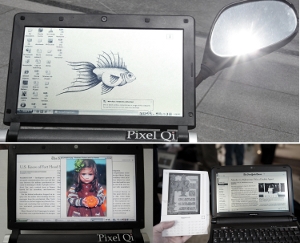When the business model is advertising
What does “open” really mean when that which is “open” is used to make money with advertising? Lots of money goes to the content aggregators - these are those last in the chain. Why just them?
Jaron Lanier asked me these questions while I was visiting him at his home in Berkeley a few weeks back.
I have been asking him (and many others) for advice. I’m trying to figure out how to leverage open design principles at Pixel Qi. Open Hardware is a challenge: This because the development of, for example, a new screen, can cost several million dollars. Worse, there are only about 10 companies in the world capable of manufacturing such a screen, and these manufacturers have their own problems.
I write this from Taiwan - where I have spent the majority of my time for the past few years.
Over here, it’s widely predicted that TFT-LCD factories are headed for tough times by the end of this year. Why: in short - because most people have already bought their big-screen HDTVs and don’t need to replace them yet.
The challenge for the TFT-LCD factories is to try to stay as fullyloaded as possible. An idle factory is extremely expensive. So, the big LCD makers are focused on methods to slash the costs of screens, to try to move more product through despite the predicted slow down. Pixel Qi is working closely with them on this, but our core competence is not just in slashing costs. We believe the way to lower cost is by creating new screens. Screens with different functionality: e-paper readability, vastly lower power consumption, lower environmentally impact, higher resolution. As we push the development of our inventions we are also patenting them. How we use these patents will be determined in the future, but we are progressing on making new screens and new machines that drastically slash current price-points while improving performance - as soon as possible
Given this - How can Pixel Qi be more open in this process (or should it be?) - Your thoughts are most welcome.

With hardware, I think you have to be secretive and patent quickly, if only to defend and recover the significant upfront production costs.
But you can always set up a patent system that once the ROI for screen makers reaches a certain point, whatever is deemed sufficient to entice production, and/or support the next round of innovation, the patent is opened for social impact usage.
That way there is enough economic benefit to fund innovation, but not a stranglehold on product diffusion. Bennetech is a great example of this in software - it takes code from patent holders and re-purposes it for nonprofit use.
Open Hardware
If you follow a method common in academic research (which I am sure you are familiar with), where what is publicly reported or known is about five years behind your current research, that should allow enough protection [patents, commercial development/prototypes, etc.], yet fuel interest and private hacking/development.
So, short answer, you will get to your goal of open hardware, it will just take a bit of time.
If you would like to get something going quicker, then I would suggest that you post some interesting cutting edge research that is available but perhaps not widely known and ask for ideas regarding a specific application. This need not be your research but areas of interest to you. Something akin to what a major adviser would do with graduate students.
Put a couple of people in charge of this project and pattern it after Thomas Edison’s workshop, only brought into the 21st Century.
“There are no rules here, we’re just trying to accomplish something.”
Opus
Congratulations on your Time recognition. Please continue to blaze trails, candidly describe the technical and business challenges, and help us rethink computing and display devices.
Interested in any comments you may have on the news of OS contractual limitations on small, low-power computers:
http://www.macworld.co.uk/business/news/index.cfm?newsid=21271
The display lady needs two good eyes so here’s wishing for a speedy recovery. Try some eye Qigong.
Knowing that this commentary is a bit dated i keep it short. leveraging an open source piece of hardware might be as easy as simplifying the amount of technology it takes to reproduce it. it doesn’t help the world if the world cant make it. admittedly that’s a whole new ball game and means making the technology to create it much simpler.